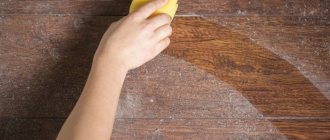In order for books from your home library to please not only you, but also your descendants, they require careful care. Dry clean twice a month. Treat publications with moisture-resistant binding with a soap solution. Remove odor with baking soda and mold with boric acid.
Proper care will not only extend the life of the publication, but will also protect its owner from allergic reactions arising from paper dust. We will learn how to clean books from dust, dirt, odors, and also get rid of mold stains.
Dry cleaning
It is recommended at least once every two weeks for publications stored in lockable shelves:
- Remove the books from the cabinet and wipe down the surfaces first.
- Leave to ventilate until the internal surfaces are completely dry.
- Start cleaning out your books. Wipe the cover with a dry microfiber cloth, and go through the sides with a vacuum cleaner.
- Place the volumes in their original place.
Wipe the cabinet with a damp cloth and glass cleaner.
It is not recommended to use a dust blower or hair dryer, as scattered dust particles will re-settle on the surface.
Finding out what needs to be cleaned from a book
- So, let's collect the necessary books. We will set up a comfortable work area with good lighting.
- Check the book from spine to spine and mentally list all the areas that need cleaning. If there are many areas, you can mark them or write them down on a piece of paper. This will help you minimize damage to fairly old books that have a lot of dirt on them.
- Place your book on a soft table surface (you can add a terry towel) to prepare for cleaning.
Wet cleaning
This method is suitable for cleaning publications with moisture-resistant covers:
- Remove dirt from the side surfaces.
- If the cover is dusty, simply wipe it with a slightly damp cloth. Treat greasy areas with a cloth soaked in soap or soda solution.
- Remove any remaining detergent with a damp cloth.
- Leave the book to dry. To speed up the process, you can use a hairdryer.
- Place the cleaned items in the bookcase.
Important ! Do not dry books in direct sunlight.
Signs of dust mites in your home
Scientists at the University of Massachusetts conducted studies that found that rural children are allergic to dust mites several times less often than urban children. It is believed that this reaction is caused by earlier contact of the former with domestic and farm animals, on whose fur there are more than enough such parasites. But the latter live in more sterile conditions, and therefore experience an allergic reaction many times more often.
In normal house dust, that is, in an amount safe for human health, there should be no more than 100 individuals per 1 gram. But statistics from apartment studies have shown that there are often hundreds of times more of them - up to 50 thousand per gram of dust. Dust mites are dangerous primarily because they produce harmful substances in huge volumes. Allergens produced by these mites cause an increased reaction of the human body to them in the form of:
- Bronchial asthma;
- Allergic rhinitis;
- Atopic dermatitis;
- Conjunctivitis.
That is, dust mites can cause allergies, manifesting themselves in the form of skin rashes, bumpy areas of redness, problems with respiratory function, wheezing, shortness of breath, tearing and discharge from the eyes and nose. Simply treating this condition will not help to cope with the disease called tick allergy. This does not eliminate the cause of the development of the pathology, and therefore, if the patient feels relief, it will only be temporary. Comprehensive methods of getting rid of ticks and the result of their impact on the patient are needed.
In children with tick-borne bronchial asthma, the frequency of attacks increases in the spring-autumn period, when temperature and humidity reach the level necessary for the reproduction and activation of dust mites. Moreover, attacks are more common at night, that is, when the child comes into contact with the affected surface - the bed.
Getting rid of the smell
A book that is popular not only wears out over time, but also acquires a characteristic smell. A cheap remedy that every housewife has on hand will help get rid of it:
- Cover the table with a piece of cloth or newspaper.
- Pour a pack of soda onto the prepared surface; if there are any lumps, crush them.
- Sprinkle the powder over the book, pouring it between the pages and completely covering the cover.
- Leave for 5-6 hours.
- Shake off any remaining baking soda over the sink.
Borax powder can be used instead of sodium bicarbonate. Both products have disinfectant properties.
How to properly store books?
Proper storage conditions are the key to the “health” and safety of books. First, let’s figure out what books are “afraid of.”
Paper products - books, albums, magazines - do not like high humidity. Books become covered with mold, and a small insect of white or pale yellow color appears in them - the book beetle (order of hay beetles). To avoid such unpleasant consequences, normalize the temperature and humidity conditions in the apartment.
Optimal conditions for storage are: room temperature is eighteen to twenty degrees, and humidity is not higher than sixty, but not lower than fifty percent (too dry air is harmful to human health).
When installing bookcases or shelves, keep in mind that direct sunlight is contraindicated for books. Therefore, shelves with books should be installed perpendicular to the windows.
Dust on books and shelves will accumulate much more slowly if the shelves are closed with glass doors. Ideally, books should be in an upright position, not too close to each other, and in one row. Book bindings will not be damaged by skew if you make sure that the books are level. When books are stored in several rows, or when they are stored too tightly, printed publications are poorly ventilated, they do not “breathe,” mold stains appear on their pages and covers, and they acquire a characteristic musty smell.
Removing contaminants
It is better to remove fresh stains immediately
The following manipulations will help restore the original appearance of the tome:
- Erase pen marks, pencil marks or small stains with an eraser.
- Treat blood or insect marks with hydrogen peroxide.
- Remove blots from paint, cement and other heavy contaminants using fine-grained sandpaper.
Advice : preventive measures are always better than eliminating the consequences, so before reading, put a cover on the source of knowledge and do not eat while sitting at the book.
Description of the pest
Dust mites are small parasites that settle in living spaces and multiply there quite quickly. Their sizes are so small that it is almost impossible to see them with the naked eye. On average, their value can fluctuate between 0.1-0.5 mm, and therefore a person usually has no idea that he lives in a densely populated “communal apartment”.
These parasites are widespread across literally all continents. The normal life cycle of one individual is about 65-80 days. During this period, the female can make hundreds, if not thousands of clutches, each of which will contain up to 60 eggs. The ideal environment for their habitat is a temperature in the range of 18-25°C, and with high humidity they begin to actively reproduce.
It is noteworthy that mites in house dust, or rather their metabolic products, are one of the most common causes of asthma.
In addition to dust, these arthropods can safely live in:
- Mattresses (they especially love pile products);
- Woolen blankets;
- Bed linen;
- Upholstered furniture;
- Pillows;
- Perinakh;
- Soft baby toys;
- Animal bed and so on.
It is noteworthy that if synthetic analogues of the above elements are used for a long time without regular processing and washing, they will also not disdain. A dust mite is capable of clinging to clothing, and therefore, even if there was no dust mite in the apartment before, it is enough to bring one individual from public transport, sitting at school or another place to your home so that the invader can inhabit the area in the shortest possible time.
But the most favorite habitat of this pest is the bed. In just one week, about 1 g of skin particles are retained in the underwear of just one person. In one day, a person generally loses up to 1.5 skin cells, dandruff and other elements. Considering that sweat and heat are still released during sleep, this place is perhaps the best living space for dust mites.
1 g of dust can contain up to 150 species of dust mites. These parasites can be eliminated without problems using folk remedies or chemicals at home.
Regular cleaning of bookshelves
It is better to remove book dust with a vacuum cleaner. The vacuum cleaner attachment kit includes a special brush with long bristles. It is just perfect for cleaning books.
You also need to thoroughly vacuum the shelves and wipe them with a damp cloth. Then wipe the book covers with a slightly dampened soft cloth. When cleaning books from dust, review them carefully; perhaps they require more thorough cleaning or minor repairs.
It is better to entrust especially expensive or antique books to a specialist for restoration, but you can remove stains and marks with a pen and pencil yourself.
How to remove dust
- Pen and pencil marks can be erased with an eraser. All movements are performed in one direction so that the pages do not tear.
- Waterproof glossy finishes can be cleaned with tea tree essential oil. The product disinfects and eliminates unpleasant odors. Sticky traces of price tags from thick covers are removed in the same way.
- Large accumulations of dirt are carefully removed with fine sandpaper.
In recent years, manufacturers have been actively advertising the electric model of such cleaning brushes. A motor is built into its handle, which enhances static electricity, due to which dust is even more attracted to the pipidaster. The charge is not dangerous to humans, but the batteries in the tool will need to be changed frequently.
Folk remedies Recipes for masks At home Hair loss in women How to stimulate growth Causes of hair loss Hair loss in men Review of vitamins Helpful tips
Why do you like the smell of old books?
Many people like the scent of old books. According to the journal Heritage Science, the results of a study in which several hundred people were asked to smell old books surprised the public. Thus, 100% of subjects noted strong woody notes; 86% noticed smoky accords; 71% felt earthy tints, and 41% admired vanilla shades. At the same time, almost 70% liked the smell, 14% considered it moderately pleasant, another 14% considered it neutral, and only 2% of volunteers noted that the aroma was unpleasant.
The smell of old books excites the imagination and makes it possible to imagine the people who previously touched the pages. That is why scientists strive to decompose the aroma into molecules in order to, if necessary, completely immerse themselves in the atmosphere of the past. This is relevant, for example, when holding exhibitions in a museum or real-life recreations of historical productions.
The real smell of old books that hovers in a library cannot be replicated. It is formed by volatile compounds that are released as a result of the decomposition of cellulose and lignin, the main components of wood. Modern books will smell differently, because in the chemical composition of modern paper the lignin content is minimized.
If you find an error, please select a piece of text and press Ctrl+Enter.
About dusty books and missing walruses
Those who visited the Soviet Union probably remember the fashion that was still relevant in the late 1980s: multi-volume collected works displayed in a prominent place in the apartment (usually in the hall, on the “hill”). Alexander Dumas in 18 volumes or Agatha Christie in 20, arranged in a beautiful fan, among crystal trinkets, were a source of pride for their owners, luxury, Soviet chic. In the most reading country in the world, books often became scarce, but the unobtrusive demonstration of what others do not have always “contains inexplicable pleasures for the mortal heart.”
I had to see the fading phenomena of this fashion back in the 1990s and even in the “zero”. What always surprised me: most often these books... were not read by the owners. You pick up a volume and realize that you are its “discoverer”; no one has ever turned these pages before you (which is easily determined by the slightly glued sheets). Apparently, there is no time for 10... 20... 30 years. I had no time. Affairs.
The new era brought with it a new fashion, and positioning oneself as a book lover was no longer relevant. The furniture in the apartments was updated, repairs were made - and the once scarce, but now dust-covered collections of works quietly migrated to garages, storage rooms, and basements. Or even in the trash. Readers quietly retrained as TV viewers and Internet users, and few people began to be interested in the adventures of detectives or musketeers. A book requires minimal self-respect in the form of silence, time, attention. Something that is not needed either when clicking a remote control or when surfing the Internet. And many unknowingly choose the easier one.
This example teaches us a simple thing: an external demonstration of something without an internal essence, a form without content, is an absolutely useless waste of time and effort. A person who does not appreciate books, for whom collected works are just an element of decor (some even chose covers to match the color of the wall), is unlikely to love books. And over time, he will move them somewhere out of sight. The same rule is often projected onto spiritual life.
Once in the temple, I noticed my grandmother, who during the service was baptized at a rate of about 10 times per minute. The entire Liturgy, from beginning to end. It was a Sunday, there were quite a lot of people, and the temple crowd somehow unnoticeably carried me out, placing me shoulder to shoulder with this apparently zealous prayer worker.
A priest comes out with a Chalice and exclaims: “Our great lord and father, His Holiness Patriarch Kirill...” And then I hear a furious whisper nearby: “Pimena! Pimena! Pimen was the last Orthodox patriarch!” At the same time, the speed of baptism (so to speak) has increased further - up to 15 times per minute. Having subsequently observed this “zealot,” I became a witness: there were a lot of comments to the priest (he reads the Gospel wrong), to the choir (he sings wrong and wrong), and to us, the sinful parishioners surrounding this all-knowing ascetic. Outward piety in reality turned out to be a regrettable empty shell.
And one more example from life, probably familiar to many. On Epiphany, the rivers, lakes and springs of our country attract a huge number of people. On a (most often) working day, young, healthy, broad-shouldered men en masse find both the time and the opportunity to plunge into Epiphany water. There are often long queues even at night. Then take a photo as a keepsake and unobtrusively post the photo on social networks. Or in a conversation, casually mention: “I took a dip yesterday - oh, good!” in order to amaze the more heat-loving and timid with their bravery.
Of course, swimming in an ice hole has no dogmatic or canonical basis. This is a tradition that everyone decides to follow (or not to follow) for themselves. But still, this is a certain form, method, attempt to please God. A person singles out the day of Epiphany from a series of everyday life, celebrates it (at least by visiting a pond) and makes a spiritual and physical effort on himself, plunging into the icy Jordan. A kind of sacrifice of your time and comfort.
Is coming to the temple once a week really a more difficult task than diving into an ice hole?!
A simple question: where do these courageous “walruses” go next? Why on Sundays throughout the year 90% or more of our parishioners are grandmothers, aunties and children (brought in just before Communion)? Is going to the nearest temple for an hour and a half once a week, on a day off, a more difficult task than diving into an ice hole at -20°C?
The novel by the French writer Michel Houellebecq, “Humility”, describes a quite probable situation – already in the near European future –: Islam is becoming the main political force in France. In a country with historically strong Catholic traditions, which for many over time turned into a ritual formality. The main character himself cannot really figure out what he believes in, and in his attempts to have some theological disputes with Muslims, he is expectedly defeated.
Thus, the imitation of external piety, following the traditional way of life by inertia, without reflection, inevitably falls apart over time like a house of cards, and even without any serious tests. Simply following the majority opinion or a higher salary (in the novel, using the example of a university teacher) makes a person shrug his shoulders: “What’s wrong with that?” - and change your faith.
Books that are not read are sooner or later thrown away.
Doesn't the same fate await the outward imitation of piety?
Why do old books smell?
The specific aroma of time-worn books appears due to the decomposition of chemical compounds used in the production of paper. These are primarily cellulose fibers and lignin, which holds them together and fills the voids.
Lignin is a natural polymer compound found in the vascular cells of some plants. This substance is very labile and easily interacts with chemicals or the environment.
Under the influence of oxygen, lignin decomposes into acids, which destroy cellulose fibers. The process is unavoidable, although large amounts of lignin are removed in the production of strong and durable paper. This is done because the polymer negatively affects the paper-forming properties of cellulose.
What is the danger?
Book dust, which regularly settles not only on furniture, but also directly on the volumes themselves, often becomes the cause of such diseases as:
- allergic rhinitis, the symptoms of which are: redness of the mucous membranes of the eyes, sneezing, runny nose, cough, sore throat, easily confused with manifestations of ARVI;
- bronchial asthma;
- Quincke's edema, which can be fatal without timely medical care.
The reason for this lies in microscopic parasites contained in the dust on bookshelves. We are talking about false scorpions and book mites, the waste products of which not only spoil the pages of tomes, but also cause significant damage to human health. Moreover, the danger increases as the publication ages. It is not for nothing that archive employees are required to work with books wearing a respirator and disposable gloves.
To avoid severe allergic reactions, doctors recommend not keeping paper works that are more than ten years old in your home library. In fact, if you properly care for your volumes, you won’t have to resort to such radical methods. And for this you need to know how to get rid of book dust.
How to get rid of dust: 11 tips
- If the notes are written in pencil, it is easy to remove them with a special eraser. The only nuance that you should pay attention to is that you need to use the eraser carefully, without exerting force, so as not to damage the sheets of paper. Writing with a ballpoint or ink pen is much more difficult to remove. Find a special ink eraser and use it.
- Ink blots are removed with hydrogen peroxide. Using a cotton pad soaked in peroxide, treat the ink stain, then blot thoroughly with a paper towel. Do not place books with wet pages on the shelf; they must first be thoroughly dried.
- Grease stains on book pages can be removed with tooth powder or chalk. This method is only suitable for fresh stains. Chalk powder is applied to the stain and ironed on top through a white sheet of paper or through a white paper napkin.
- Old grease stains can be removed with aviation gasoline or a mixture of gasoline and magnesium oxide (burnt magnesia).
- The rust that appears will become discolored after wiping the stain with a cotton pad soaked in citric acid.
- Wash any remaining finger stains with soapy water. A gentler method is to rub the finger stains with soap, then wipe off the soap with a soft, damp cloth.
- Remove surface mold stains that have formed on damp pages using a soft brush or a soft vacuum cleaner attachment. . Make sure that mold spores do not get back onto the paper. Then treat the stains with ammonia (apply it to a cotton pad and wipe the infected areas, covering a slightly larger area). The same procedure can be done using a three percent formaldehyde solution. Let the paper dry. If stains are still visible, wipe them with hydrogen peroxide.
Anti-dust polish can only be applied to a clean and dry surface, but be sure to read the instructions. If you use anti-dust products correctly, they will repel it, and the room will look much cleaner.
A proven way to declutter your bookcase
This method is popularized by Marie Kondo.
- Separate adult and children's literature, collect each category in one place.
- Pick up each publication and ask yourself if it sparks joy.
- Put the book down if the answer is yes. Prepare to throw it away (take it to bookcrossing) if the answer is “no”.
- Designate a place for each selected book so that the shelves are always organized.
This method has a high level of subjectivity. However, it allows you to leave publications that are really expensive to be read and re-read.











